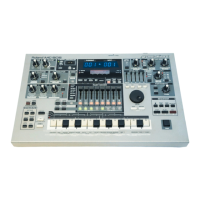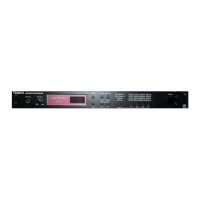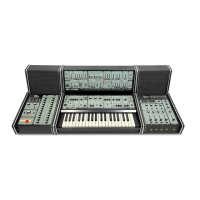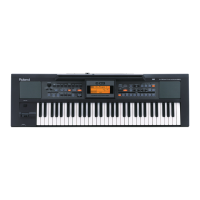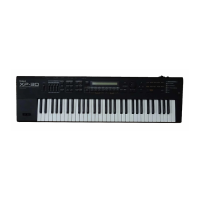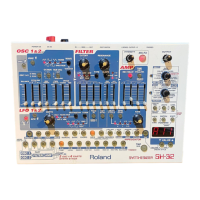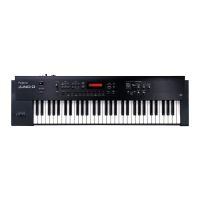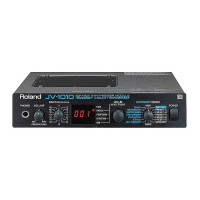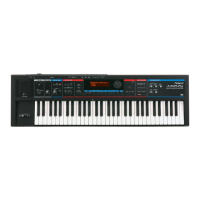Do you have a question about the Roland MC-303 Groovebox and is the answer not in the manual?
Explains how the arpeggio function allows for easy creation and playback of arpeggiated patterns.
Details the Play Quantize function, enabling users to change the 'groove' of patterns in realtime.
Highlights RTM (Realtime Modify) for sound changes and features for easy live performance operation.
Describes the low boost circuit, enhancing powerful sound creation with low frequencies.
Provides critical warnings and cautions regarding fire, electric shock, and injury prevention during unit operation.
Explains the meaning of warning and caution symbols used throughout the manual to ensure user safety.
Advises on safe use of the AC adapter and battery handling, including power-related issues.
Covers proper unit placement, cleaning procedures, and guidance for repairs and data handling.
Details memory backup procedures and additional precautions to prevent data loss or unit damage.
Identifies and describes the functions of all controls on the MC-303's front panel.
Details the various input and output connectors found on the rear of the MC-303.
Explains the basic organization of the MC-303, including its controller, sound source, and sequencer components.
Describes how the MC-303 produces sound, the nature of its parts and tones, and the categories of patterns.
Details the sequencer's role in recording and playback, and introduces concepts like Preset, User, and Variation patterns.
Guides on selecting, playing, and navigating through patterns, including tempo and display information.
Explains how to adjust the tempo of a pattern and view its measure count.
Covers muting individual parts or rhythm instruments and transposing patterns during playback.
Details storing arpeggio settings in Pattern Sets and registering patterns for later use.
Guides on selecting sounds, using octave shifts, and playing sounds via MIDI or keyboard.
Details modifying part parameters like cutoff, resonance, LFO, envelope, and menu-based settings.
Explains realtime adjustments using knobs for volume, pan, portamento, and timbre.
Covers Envelope (Attack, Decay, Release) and LFO (Waveform, Rate, Depth) for sound shaping.
Details the application and adjustment of Delay, Reverb, and Chorus effects for sound enhancement.
Covers selecting Flanger/Chorus types and adjusting parameters like speed, level, pre-LPF, and feedback.
Explains how to save customized pattern settings, including tone, rhythm, and effect configurations.
Guides on using the RPS function to play back recorded phrases from the keyboard.
Details the process of registering phrases in RPS sets and re-registering existing ones.
Introduces the arpeggiator, its various styles, and how to select and apply them.
Explains adding expression (Accent Rate) and adjusting the pitch range (Octave Range) for arpeggios.
Covers advanced settings for arpeggios, including motif, beat pattern, and backbeat timing adjustments.
Guides on selecting specific parts for Play Quantize and applying grid quantize.
Explains specifying resolution, applying shuffle quantize, and adjusting groove templates for rhythmic feel.
Details the process of selecting and applying groove templates to imbue patterns with specific rhythmic characteristics.
Covers realtime recording, including loop replacement and smooth recording between patterns.
Explains step recording methods, note input, and using the microscope for editing recorded data.
Details operations like copying, deleting, inserting, and modifying recorded patterns and their data.
Covers transposing, changing note velocity, and adjusting timing (Shift Clock) for recorded patterns.
Guides on selecting patterns and recording them into songs, managing pattern input and sequence.
Explains how to play back songs, store modified settings, and manage tempo and effect parameters.
Details operations for copying songs and deleting unwanted patterns within a song.
Covers inserting patterns into songs and modifying pattern settings within the song context.
Explains pedal function assignment and how to adjust the MC-303's tuning.
Details synchronization modes, metronome settings, volume, and checking available memory.
Covers adjusting note velocity and understanding MIDI data transmission for system settings.
Explains MIDI connectors, channels, and controlling the MC-303 with external MIDI devices.
Details synchronizing with external sequencers and saving/loading data via MIDI (Bulk Dump).
Describes using the MC-303 in Sound Module mode for controlling it with external MIDI sources.
Provides solutions for common operational problems and explains error messages.
Details restoring factory settings and lists for tones, patterns, and MIDI implementation.
Includes topical index, specifications, and general index for quick reference.
Lists key technical specifications including dimensions, weight, power, and control features.
Details included accessories and optional items available for the MC-303.
Explains how to adjust the playback timing for RPS phrases, covering 16th note, quarter note, and measure settings.
| Type | Groovebox |
|---|---|
| Polyphony | 28 voices |
| User Patterns | 50 |
| Preset Tones | 448 |
| Drum Kits | 12 |
| Sequencer | Yes |
| Arpeggiator | Yes |
| MIDI | In, Out, Thru |
| Year Released | 1996 |
| Parts | 8 parts |
| Effects | Reverb, Delay |
| Display | LCD |
| Outputs | Stereo Out, Headphone Out |
| Power Supply | AC Adaptor |
